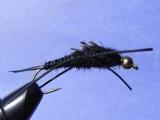Kaufmann’s Stone
By Gary Lewis


In late May and early June, the Deschutes River stoneflies and salmonflies turn toward shore to complete their transformation into the winged adult phase.
At this time of year, if there is no hatch visible and dry flies prove unproductive, trout may be feeding on the nymphs. If you can see fish rolling close to the bottom, their scales flashing in the sunlight, they are probably nymphing.
Tie on a heavily weighted Kaufmann Stone and wade out below the fish. Cast far enough upstream that the fly has time to sink. Let it tumble freely, stripping in line as the fly comes back to you. Watch your line or a strike indicator for evidence of a take.
The Kaufmann's Stone is tied on an extra long nymph hook in sizes 2 through 10. Wrap heavily with lead wire and tie in a tail of two black or brown goose quill fibers. Mix brown and black dubbing material for the abdomen and thorax, ribbing with swannundaze, a flat, oval plastic. Make the wingcase from a turkey tail feather, cutting in a 'V' and layering in three sections. For antennae use two more goose quill fibers to match the tail.


